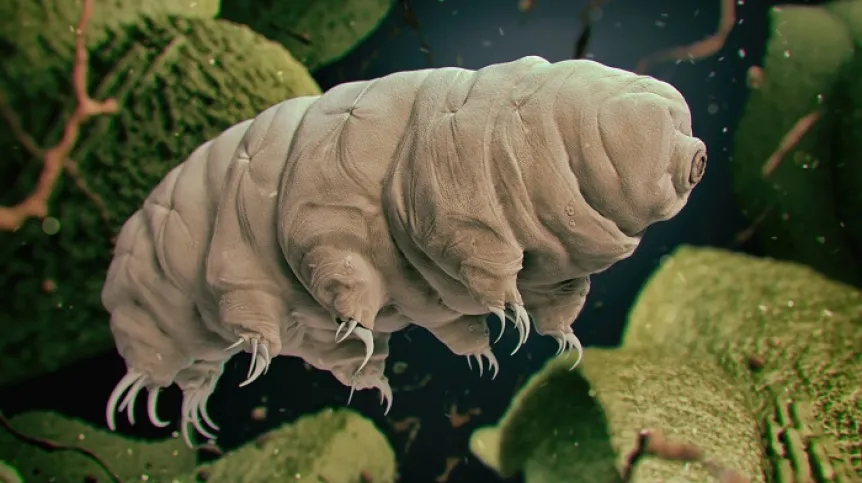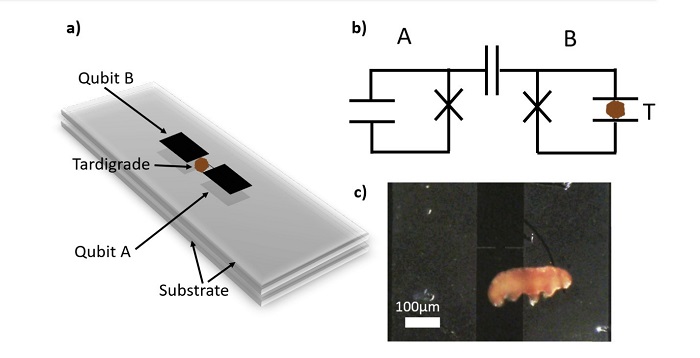
Scientists have sparked an academic row after saying they have found that tiny invertebrate capable of surviving in a vacuum and at a temperature close to absolute zero can also survive quantum entanglement.
The researchers from Singapore and the University of Gdansk said that after creating the quantum entanglement, the tardigrade (affectionately named Neil Wormstrong) later came back to life.
Making their research results available as a preprint on arXiv, the topic has now started a debate in the scientific world, with quantum physicist Professor Jacek Szczytko from the University of Warsaw saying bluntly: “I would not rush to talking about a Schrödinger's tardigrade.”
TARDIGRADE-MAN WOULD BE THE TOUGHEST SUPERHERO
The part that is not debatable is that in the new experiment, tardigrades broke a new resilience record.
Their resilience has long been known. Tardigrades, tiny aquatic invertebrates (a queue of a hundred tardigrades arranged one behind the other would measure between 1 mm and 10 cm) can survive in conditions close to a vacuum, at temperatures close to absolute zero, at a temperature of 160 degrees Celsius, in high pressure water depths. They can live without food for 30 years.
Tardigrades owe these superpowers to their ability to enter a state, in which their metabolism almost completely ceases. When the conditions become favourable again, tardigrades return to life.
In the new experiment, physicists decided to check if these animals could survive 2.5 weeks in a vacuum at 10 millikelvin (less than one hundredth of a degree Celsius above the lowest temperature limit). No tardigrade had survived for so long in such cold conditions before.
WHY FREEZE A TARDIGRADE
Dr. Tomasz Paterek from the University of Gdansk said that cooling a tardigrade to a temperature so low that it does not occur naturally in the known Universe was necessary to verify whether these animals could survive quantum entanglement.
He said: “In this tardigrade experiment, we wanted to study how matter in some sense alive interacts with the quantum matter.”

Quantum phenomena, different than those observed in the macroscopic world, are the easiest to observe at temperatures close to absolute zero and in a vacuum. These conditions are so calm that quantum madness is easier to see. The warmer it gets, the greater the risk that photons of thermal radiation bombard the experiment and bring chaos that will obscure quantum phenomena.
Tardigrades, animals unafraid of such conditions close to absolute zero, were natural candidates for this study.
QUBITS ARE VARIABLE
Researchers under the supervision of R. Dumke from Nanyang Technological University in Singapore have prepared a system they refer to as a qubit, or quantum bit, in which the superposition of states with different energies can occur.
The system could be prepared to have only one of two specific energy values. If the system interacts with microwaves for a specified time, it will jump to a higher energy level. Of it interacts for half of that time, it is never known what will happen. However, since it is the quantum world, instead of being in one or the other state, the system will be in a superposition of these two states with different energies, in the space between these energies. This superposition disappears only at the moment of measurement. That is when the system returns from the quantum world to the world of classical physics and begins to have one of the two values.
HOPELESS SUPERPOSITION
On one of such qubits, where quantum charges go crazy, researchers placed a tardigrade so that it changed the parameters of the system.
In the experiment, researchers did not measure what was happening to the tardigrade, but treated the device along with the animal located on it as one system. Another part of the experiment was the second qubit placed below. Paterek explains that the upper qubit with the tardigrade was tangled with the lower qubit by a pulse sequence.
In the next step, researchers used tomography to check the output state of the tardigrade qubit/lower qubit system. It lasted 2.5 weeks.
According to the authors, there was a superposition during the experiment and the tardigrade was a part of it. The parameters of the system with the tardigrade were changing consistently with the simulations carried out beforehand, the authors say.
In the title of their paper, the researchers interpret that a quantum entanglement occurred between qubits and the tardigrade.
Professor Jacek Szczytko from the Faculty of Physics of the University of Warsaw, however, is a bit less optimistic in his interpretation. In its assessment, the publication shows that the tardigrade, which consists of water and various proteins, acted like a dielectric located on the joints.
He said: “The tardigrade may have been a passenger in this experiment and may have changed resonance frequencies in this system, but I would not say that it was in a quantum entanglement.”
He added that the simulation of physical phenomena that were supposed to occur in the tardigrade during the entanglement, also leaves a lot to be desired, saying: “The authors reduced the entire complicated biochemistry of this animal to the fact that the animal consisted of many small dipoles.”
He continued that to describe quantum entanglement, the system must be very precisely defined, concluding that while the paper is not necessarily a breakthrough, it is interesting because it prompts reflection on life, death and quantum physics.
PAP - Science in Poland, Ludwika Tomala
lt/ ekr/ kap/
tr. RL













